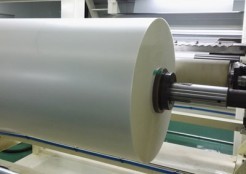Informations
PVA (Polyvinyl Alcohol) water soluble films have gained widespread use in various industries due to their unique properties
and environmentally friendly nature. These films are used in a wide range of
applications, including packaging, agriculture, textiles, and more. However,
not all PVA water soluble films are created equal. In this essay, we will
explore the differences between blowing and casting processes used in PVA film
manufacturing and their impact on film properties and applications.

The blowing process involves extruding
molten PVA resin through a circular die, which is then inflated with air to
form a bubble. The bubble is then collapsed and flattened into a film. On the
other hand, the casting process involves dissolving PVA resin in water and then
spreading the solution onto a flat surface to form a film, which is then dried
to remove the water content.
One key difference between blowing and
casting PVA water soluble films is the film's physical properties. Blowing
films tend to have a higher degree of orientation, meaning that the polymer
chains are aligned in a specific direction. This results in a film with higher
tensile strength and puncture resistance, making it suitable for applications
that require greater mechanical strength, such as packaging or agricultural
films. On the other hand, casting films have a more random molecular
arrangement, resulting in a film with lower tensile strength and puncture
resistance, but with better clarity and transparency.
Another difference between blowing and
casting PVA films is the dissolving rate. Blowing films generally dissolve
faster in water compared to casting films due to their higher porosity and
larger surface area. This makes blowing films ideal for applications where
quick dissolution is desired, such as in single-use packaging or dissolvable
pouches.
Furthermore, the manufacturing process also
affects the film thickness and uniformity. Blowing films tend to have a more
consistent thickness across the film width, while casting films may have some
thickness variation due to the spreading process. This can impact the film's
performance in certain applications where consistent film thickness is crucial.


In terms of applications, blowing PVA films
are commonly used in packaging applications where mechanical strength and quick
dissolution are essential, such as in detergent pods, agrochemical packaging,
or medical packaging. On the other hand, casting PVA films are often used in
applications where clarity and transparency are important, such as in cosmetic
and personal care products, as well as in textile and embroidery industries.
In conclusion, understanding the
differences between blowing and casting PVA water soluble films is crucial in
choosing the right film for specific applications. Blowing films offer higher
tensile strength, puncture resistance, and faster dissolution rate, making them
suitable for packaging and other applications that require mechanical strength
and quick dissolution. On the other hand, casting films offer better clarity
and transparency, making them ideal for applications where visual appearance is
important. Consideration of film properties, manufacturing process, and
application requirements is essential in selecting the most appropriate PVA
water soluble film for specific needs.





